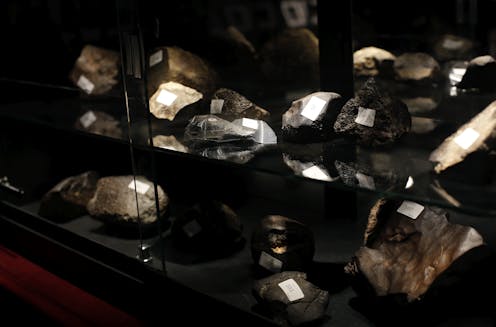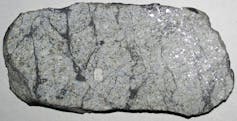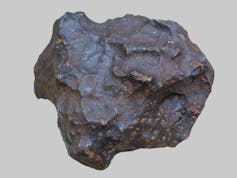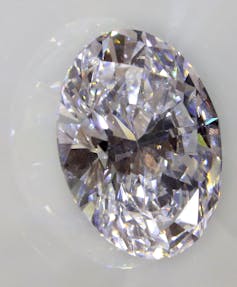Space rocks and asteroid dust are pricey, but these aren't the most expensive materials used in scie
Some space rocks you can get for free – if you know how to identify them. Rarer materials cost more, and the asteroid sample NASA just brought back has a high price tag.

After a journey of seven years and nearly 4 billion miles, NASA’s OSIRIS-REx spacecraft landed gently in the Utah desert on the morning of Sept. 24, 2023, with a precious payload. The spacecraft brought back a sample from the asteroid Bennu.

Roughly half a pound of material collected from the 85 million-ton asteroid (77.6 billion kg) will help scientists learn about the formation of the solar system, including whether asteroids like Bennu include the chemical ingredients for life.
NASA’s mission was budgeted at US$800 million and will end up costing around $1.16 billion for just under 9 ounces of sample (255 g). But is this the most expensive material known? Not even close.
I’m a professor of astronomy. I use Moon and Mars rocks in my teaching and have a modest collection of meteorites. I marvel at the fact that I can hold in my hand something that is billions of years old from billions of miles away.
The cost of sample return
A handful of asteroid works out to $132 million per ounce, or $4.7 million per gram. That’s about 70,000 times the price of gold, which has been in the range of $1,800 to $2,000 per ounce ($60 to $70 per gram) for the past few years.
The first extraterrestrial material returned to Earth came from the Apollo program. Between 1969 and 1972, six Apollo missions brought back 842 pounds (382 kg) of lunar samples.
The total price tag for the Apollo program, adjusted for inflation, was $257 billion. These Moon rocks were a relative bargain at $19 million per ounce ($674 thousand per gram), and of course Apollo had additional value in demonstrating technologies for human spaceflight.
NASA is planning to bring samples back from Mars in the early 2030s to see if any contain traces of ancient life. The Mars Sample Return mission aims to return 30 sample tubes with a total weight of a pound (450 g). The Perseverance rover has already cached 10 of these samples.
However, costs have grown because the mission is complex, involving multiple robots and spacecraft. Bringing back the samples could run $11 billion, putting their cost at $690 million per ounce ($24 million per gram), five times the unit cost of the Bennu samples.
Some space rocks are free
Some space rocks cost nothing. Almost 50 tons of free samples from the solar system rain down on the Earth every day. Most burn up in the atmosphere, but if they reach the ground they’re called meteorites, and most of those come from asteroids.
Meteorites can get costly because it can be difficult to recognize and retrieve them. Rocks all look similar unless you’re a geology expert.
Most meteorites are stony, called chondrites, and they can be bought online for as little as $15 per ounce (50 cents per gram). Chondrites differ from normal rocks in containing round grains called chondrules that formed as molten droplets in space at the birth of the solar system 4.5 billion years ago.

Iron meteorites are distinguished by a dark crust, caused by melting of the surface as they come through the atmosphere, and an internal pattern of long metallic crystals. They cost $50 per ounce ($1.77 per gram) or even higher. Pallasites are stony-iron meteorites laced with the mineral olivine. When cut and polished, they have a translucent yellow-green color and can cost over $1,000 per ounce ($35 per gram).

More than a few meteorites have reached us from the Moon and Mars. Close to 600 have been recognized as coming from the Moon, and the largest, weighing 4 pounds (1.8 kg), sold for a price that works out to be about $4,700 per ounce ($166 per gram).
About 175 meteorites are identified as having come from Mars. Buying one would cost about $11,000 per ounce ($388 per gram).
Researchers can figure out where meteorites come from by using their landing trajectories to project their paths back to the asteroid belt or comparing their composition with different classes of asteroids. Experts can tell where Moon and Mars rocks come from by their geology and mineralogy.
The limitation of these “free” samples is that there is no way to know where on the Moon or Mars they came from, which limits their scientific usefulness. Also, they start to get contaminated as soon as they land on Earth, so it’s hard to tell if any microbes within them are extraterrestrial.
Expensive elements and minerals
Some elements and minerals are expensive because they’re scarce. Simple elements in the periodic table have low prices. Per ounce, carbon costs one-third of a cent, iron costs 1 cent, aluminum costs 56 cents, and even mercury is less than a dollar (per 100 grams, carbon costs $2.40, iron costs less than a cent and alumnium costs 19 cents). Silver is $14 per ounce (50 cents per gram), and gold, $1,900 per ounce ($67 per gram).
Seven radioactive elements are extremely rare in nature and so difficult to create in the lab that they eclipse the price of NASA’s Mars Sample Return. polonium-209, the most expensive of these, costs $1.4 trillion per ounce ($49 billion per gram).
Gemstones can be expensive, too. High-quality emeralds are 10 times the price of gold, and white diamonds are 100 times the price of gold.

Some diamonds have a boron impurity that gives them a vivid blue hue. They’re found in only a handful of mines worldwide, and at $550 million per ounce ($19 million per gram) they rival the cost of the upcoming Mars samples – an ounce is 142 carats, but very few gems are that large.
The most expensive synthetic material is a tiny spherical “cage” of carbon with a nitrogen atom trapped inside. The atom inside the cage is extremely stable, so can be used for timekeeping. Endohedral fullerenes are made of carbon material that may be used to create extremely accurate atomic clocks. They can cost $4 billion per ounce ($141 million per gram).
Most expensive of all
Antimatter occurs in nature, but it’s exceptionally rare because any time an antiparticle is created it quickly annihilates with a particle and produces radiation.
The particle accelerator at CERN can produces 10 million antiprotons per minute. That sounds like a lot, but at that rate it would take billions of years and cost a billion billion (1018) dollars to generate an ounce (3.5 x 1016 dollars per gram).
Warp drives as envisaged by “Star Trek,” which are powered by matter-antimatter annihilation, will have to wait.
Chris Impey receives funding from the National Science Foundation.
Read These Next
Rural high school students are more likely than city kids to get their diplomas, but they remain les
1 in 5 students in the US are living in rural areas.
Texas cities have some of the highest preterm birth rates in the US, highlighting maternal health cr
Rates of preterm births, maternal deaths and other adverse birth outcomes are abysmal across the US,…
Why do people get headaches and migraines? A child neurologist explains the science of head pain and
Many different types of stress can trigger a headache. Luckily, there are treatments that can help stop…





